Attention:
- To avoid burns, do not change the coolant when the engine is hot.
- Wrap the lid with a thick cloth and carefully remove the lid. First loosen the cap a quarter of a turn and release the pressure. Then unscrew the cover all the way.
Draining the engine coolant
Models without air conditioning
1. Disconnect the lower hose from the radiator and remove the cap from the radiator.
Caution: Drain the coolant when it is cold.
2. Remove the reservoir and drain the coolant as follows:
- A. Slide the relay box in front of the battery.
- b. Separate a tank from a casing of the fan Having applied force in the direction of the left party of the car, remove a tank up.
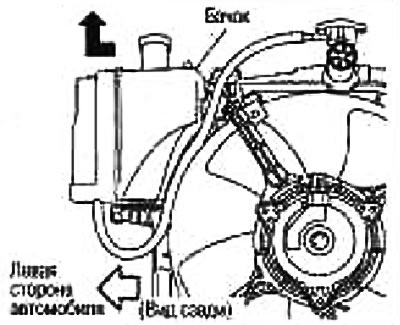
3. Check the drained coolant for contaminants such as rust, corrosion and discoloration.
If there are traces of contamination, flush the engine cooling system.
Models with air conditioning
1. Disconnect the lower hose from the radiator and remove the cap from the tank.
Caution: Drain the coolant when it is cold.
2. Remove the reservoir and drain the coolant.
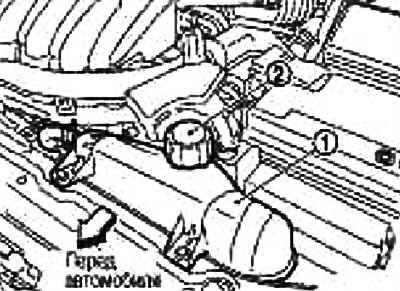
3. Check the drained coolant for contaminants such as rust, corrosion and discoloration.
If there are traces of contamination, flush the engine cooling system.
Filling the engine with coolant
1. Install the tank.
2. Connect the bottom hose to the radiator.
3. Disconnect the heater hose (from the outlet pipe of the heater hose: from the top side), as shown in fig. Keep the end of the hose at the same height as before removal.
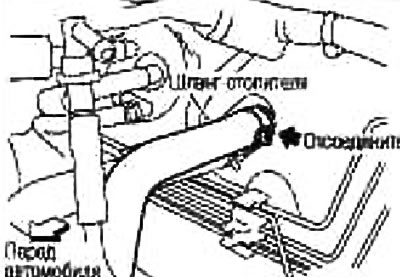
4. Fill the radiator and tank to the required level.
Add coolant slowly at a rate of less than 2 liters per minute to allow air to escape from the system.
When coolant begins to flow from the heater hose, connect the heater hose and continue refueling.
Use genuine NISSAN GENUINE COOLANT L250 or equivalent mixed with water (distilled or desalted). See chapter General information and maintenance.
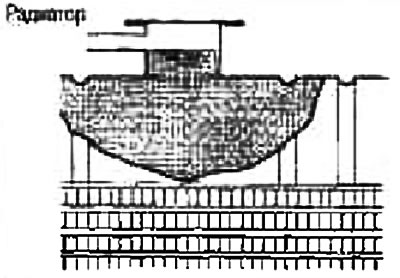
Engine coolant filling capacity:
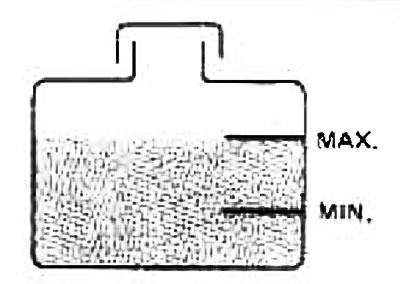
Models without air conditioning:
With tank: approx. 4.9 l
Tank: 0.7 l
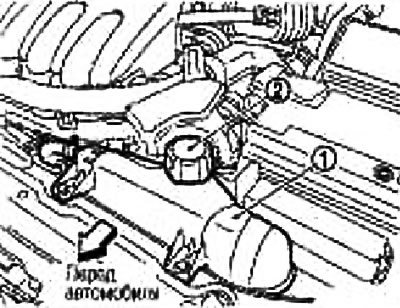
Models with air conditioning
With tank: approx. 5.3 l
Tank: 1.2 l
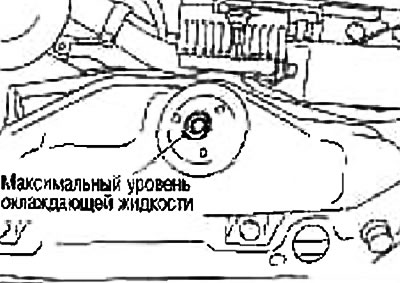
5. Start the engine and warm it up to normal operating temperature by replacing the cap on the radiator.
6. Warm up until the thermostat opens. Roughly maintain the engine speed at 3000 rpm for 10 minutes.
To determine if the thermostat is open, touch the upper radiator hose with your hand and check that hot fluid is flowing through it.
Caution: Watch the coolant temperature gauge so as not to overheat the engine.
7. Stop the engine.
8. Cooling down the engine (approx. up to 50°C or below), remove the cap from the radiator and check the coolant level. If the level is low, top up the radiator with coolant up to the filler neck and repeat from step 5.
9. When the coolant level stabilizes, fill the tank to the mark «MAX».
10. Check for leaks from the cooling system with the engine running.
11. Let the engine cool down (approx. 50°C or lower).
12. Start the engine. Perform the following operation three times. Maintain engine speed at 1000 rpm for approx. 10 seconds. Then gradually increase the speed to 3000 rpm.
13. When performing step 12, make sure that the sound of flowing fluid is not heard from the core of the radiator.
Sound can be heard from the heater.
14. If sound is heard, repeat steps 4 to 13.
Wipe excess coolant from engine.
Flushing the cooling system
1. Fill the radiator and tank with water and screw the cap on the radiator.
2. Start the engine and warm it up to normal operating temperature.
3. Press the accelerator pedal two or three times without load.
4. Stop the engine and wait until it cools down.
5. Drain the water.
6. Repeat steps 1-5 until clean water flows out of the radiator.